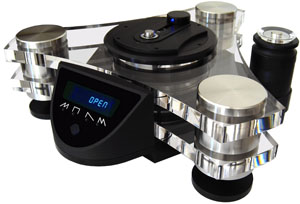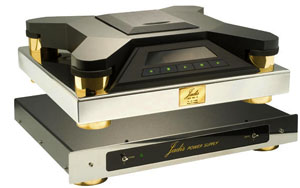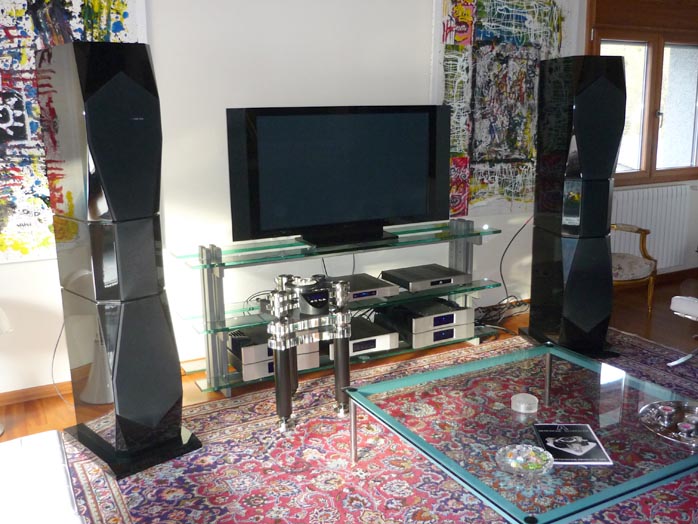This review page is supported in part by the sponsors whose ad banners are displayed below |
 |
 |
|
 |
Reviewer: Srajan Ebaen
Financial Interests: click here
Source: Esoteric UX-1, Yamamoto YDA-01, Raysonic Audio CD228 [on loan]
Preamp/Integrated: Esoteric C-03 (transistor), ModWright DM 36.5 (valves), April Music Stello Ai500 [on loan]
Amplifier: FirstWatt J2 [on loan]
Speakers: ASI Tango R, Pearl Ballerina 301-8" [on review]]
Cables: Complete loom of ASI Liveline
Stands: 2 x ASI HeartSong 3-tier racks, 2 x ASI HeartSong amp stands
Powerline conditioning: 2 x Walker Audio Velocitor S
Sundry accessories: Furutech RD-2 CD demagnetizer; Nanotech Nespa Pro; extensive use of Acoustic System Resonators, noise filters and phase inverters, Advanced Acoustics Orbis Wall & Corner units
Room size: The sound platform is 3 x 4.5m with a 2-story slanted ceiling above; four steps below continue into an 8m long combined open kitchen, dining room and office, an area which widens to 5.2m with a 2.8m ceiling; the sound platform space is open to a 2nd story landing and, via spiral stair case, to a 3rd-floor studio; concrete floor, concrete and brick walls from a converted barn with no parallel walls nor perfect right angles; short-wall setup with speaker backs facing the 8-meter expanse and 2nd-story landing.
Review Component Retail: CD One -
€4.700/€4.900 for non-tube version, RCA and RCA/XLR respectively; €5.750 for tube version (comes with XLRs); MT One - €5.300 - all prices prior to VAT (which will vary from country to country)
|

French Metronome Technologie of Toulouse began operations in 1987 producing loudspeakers. 800 pairs sold. Eventually mirroring Zanden Audio, Metronome then became famous for its digital sources and particularly, the no-holds-barred exclusively priced Kalista. With audacious modern styling, an outboard power supply and available custom stand, its expensive celebration of RedBook CD only during transitional times into cheap streaming audio was as 'counter revolutionary' as Yamada-San's iconic $40,000 four-box solution built upon 1985 silicon.
|
 |
|
 |
And just like Zanden, Metronome to this day offers no USB, Firewire, Ethernet or other interface solutions to future-proof its digital investment propositions. It's an inexplicably stubborn refusal which at this juncture many customers should find more questionable than charming. I most certainly do.*
________________
* Worse, the new CD One/CD One T offers no digital input of any persuasion, period. Even if certain prospective customers won't mind today, it does seriously limit resell potential in the future. And that undermines long-term value, never mind limits functionality. I think Dominique Giner should reconsider his position on the subject.
|
|
To retain relevance outside the ultra-fi realms, Metronome has always championed a multi-tiered approach. For digital this meant integrated one-box solutions at lower prices than the Kalista, albeit never a without a version of the Philips CD-PRO2 platform which Metronome modifies, including a blue light, stainless steel shaft and Delrin puck.
A recent reorganization of the line eliminated a surfeit of models and the CD One—adding a 'T' when fitted with two 6922s in its output stage—is the new entry-level source machine. Before we inspect it and the new stable mate MT One integrated amplifier, let's take a cursory glance at the company's CV.
|
|
|
 |
Head designer Dominique Giner states that his technical team which includes dedicated designers for the digital and analog circuits, power supplies and software control creates "highly reliable products** with outstanding musicality and practically no sonic
signature." Metronome also provides consultation to other audio firms, even OEM production. The Jadis JD1 was a Giner design for example.
____________________
** Australian 6moons contributor Edgar Kramer owned a Metronome T1i player whose laser died. Regardless of the Philips drive—also used by Accustic Arts, Nagra, Zanden and many others as the best available shy of a big Esoteric—laser-based playback always entails the potential for eventual failure just as vinyl playback mandates cartridge maintenance.
|
|

A cosmetic leit motif through the current Metronome line is "a face plate machined from a monolithic billet of 6061-T6 aluminum with a silky-smooth applied grain". For parts, the company relies on "only industrial grade, i.e. metal-film resistors for lowest noise and custom polypropylene capacitors". But really, the design focus is on circuit topology which is viewed as the "main determinant of product performance".
|
 |
This and the following were provided by global marketing manager Cyrill Dolganoff: "All products are fully evaluated during and after the design process via critical listening and technical measurements. Each
product must meet the approval of all people involved in the design and development process.
A team of expert listeners validates the performance of each new product in repeat critical auditions in a number of different
high-performance systems with dynamic and planar loudspeakers;
tube and solid-state amplifiers; CD, DVD, SACD; phono; various cables and numerous types of music.
These numerous system configurations achieve two things: the Metronome products do not develop a sound or flavor
suited only to certain types or brands of equipment; and electronic compatibility is assured.
After the completion of comparative listening sessions, a new product is listened to on its own merits for a long time without
comparative analysis. The component is critically evaluated and areas for improvement are defined and noted. Then circuit
updates and fine tuning are performed and new rounds of validating listening sessions initiated. |
|
"Dominique Giner then creates the
final touch of class and refinement with his selection of the finest materials,
craftsmanship and visual balance."
|
|
|
The complete design and development process of Metronome models is said to take between eight and eighteen months contingent upon the complexity of and performance level expectations from a new project but "all Metronome products must meet the same stringent development and testing criteria
regardless of price."

Based on Metronome's own Toulouse installation as photographed by Mr. Dolganoff above, the same stringent criteria seem rather relaxed when it comes to the quality of recommended power delivery ancillaries.

Here are three photo submissions of the small Metronome Technologie facility. Two new products are currently being prepared for a year 2010 launch. 2009 saw the launch of a 25-piece limited edition Reference Kalista SE. This model won a Hong Kong nomination for best CD player made. Defying economic trends, all 25 units sold already - at €40,000 each.

Here are Cyrill Dolganoff's two systems in his Andorra residence.

A pair of Acoustic System Int. Tango R 3-ways in the second system are echoed by one of Metronome's CD One T players in Franck Tchang's Paris atelier. When the French autodidact needs a more affordable source than his 3-piece stack of dCS gear, a CD One T spins the discs.

This now segues seamlessly into the review subject and its intended mate, the 100wpc MT One integrated with twin 400VA C-core transformers whose first five watts operate in class A.
|
|
|
|
 |
|
 |
|